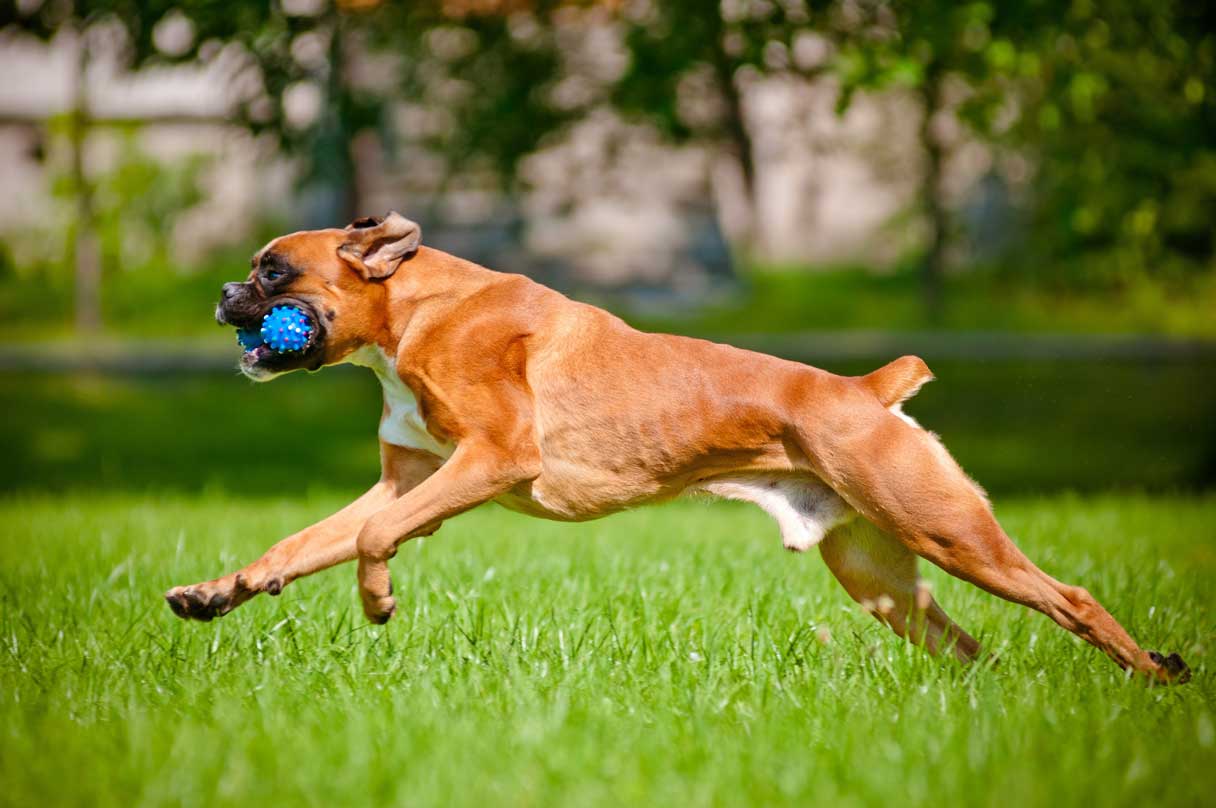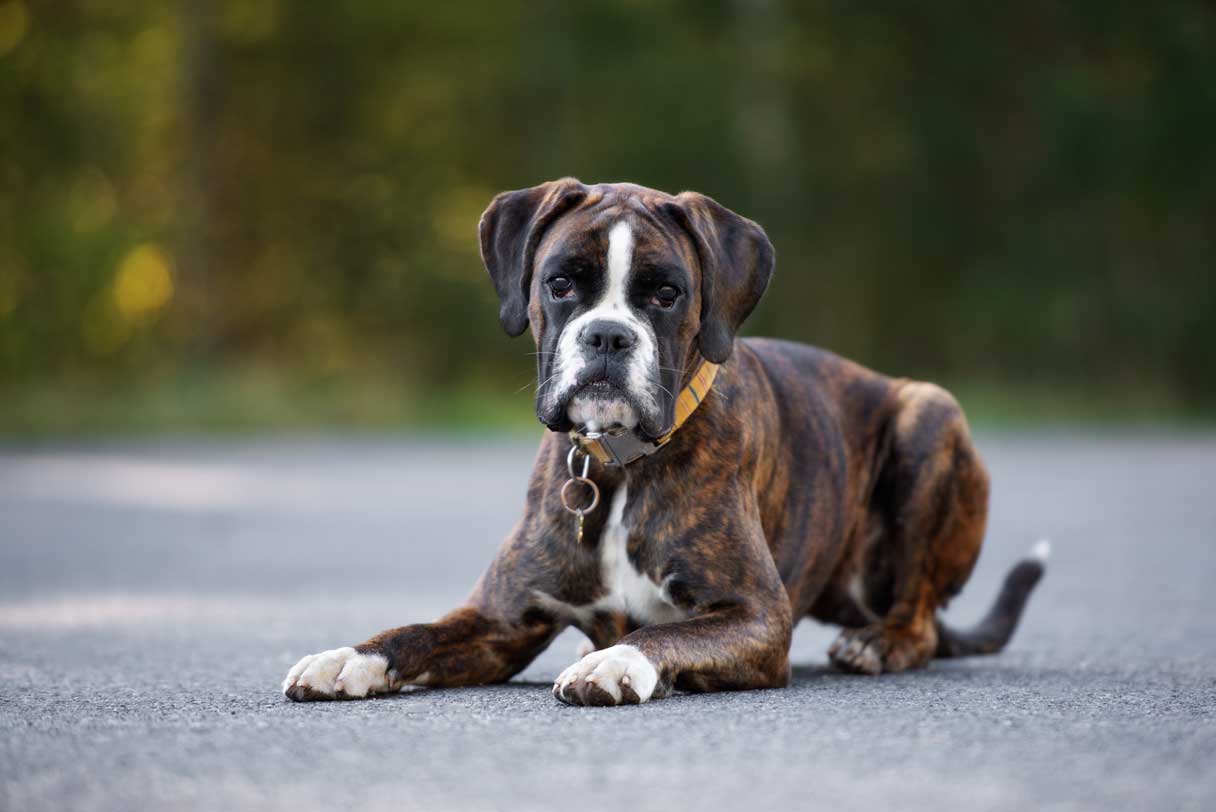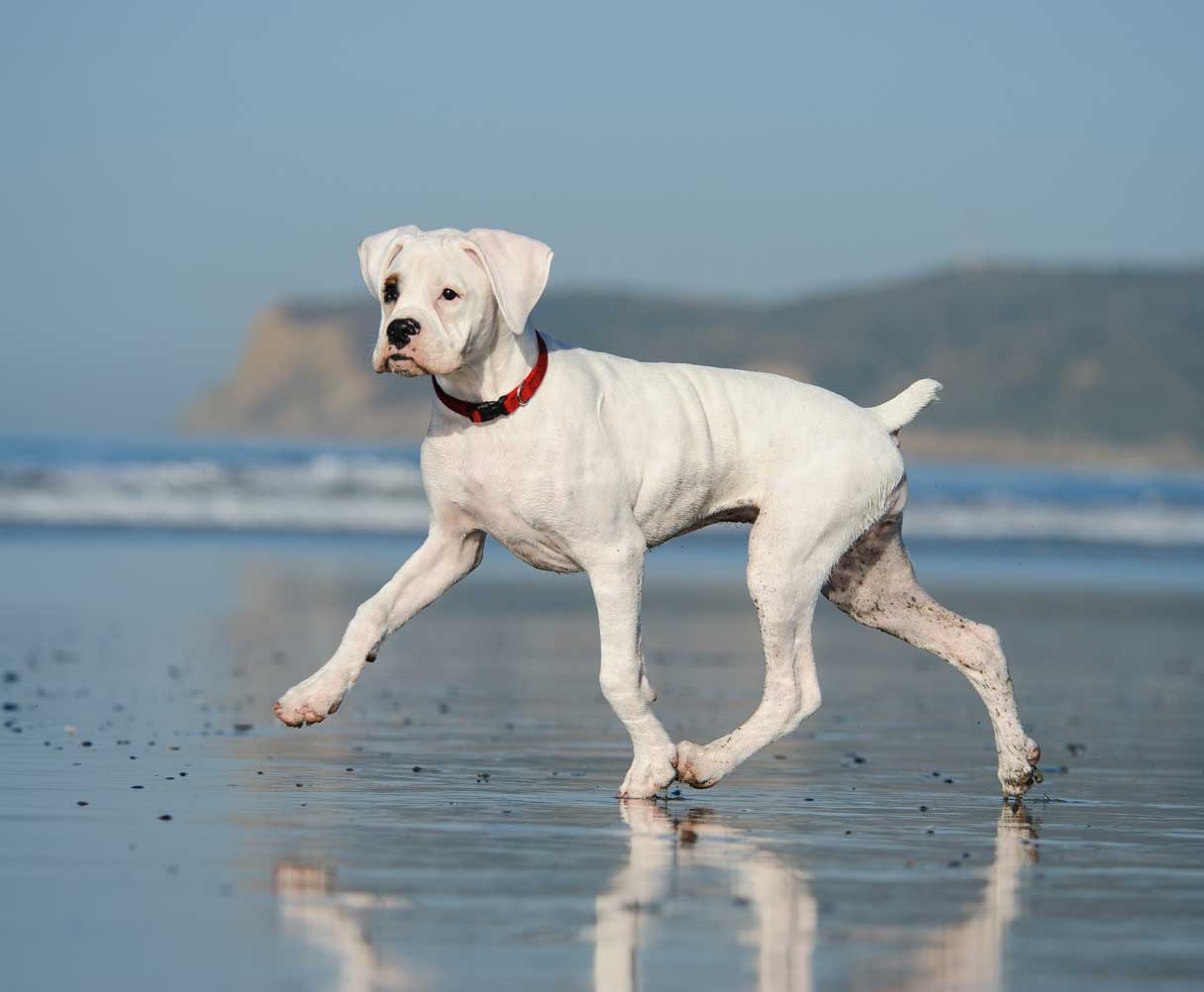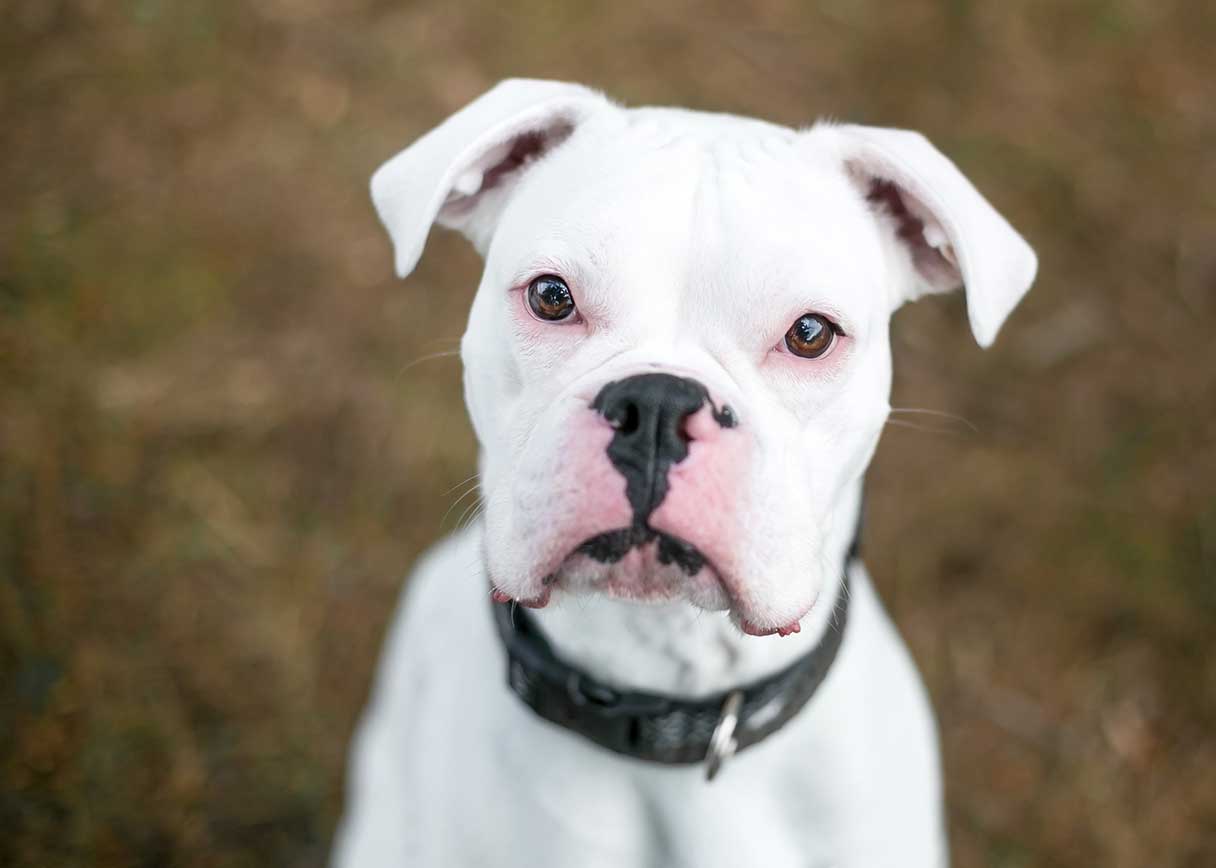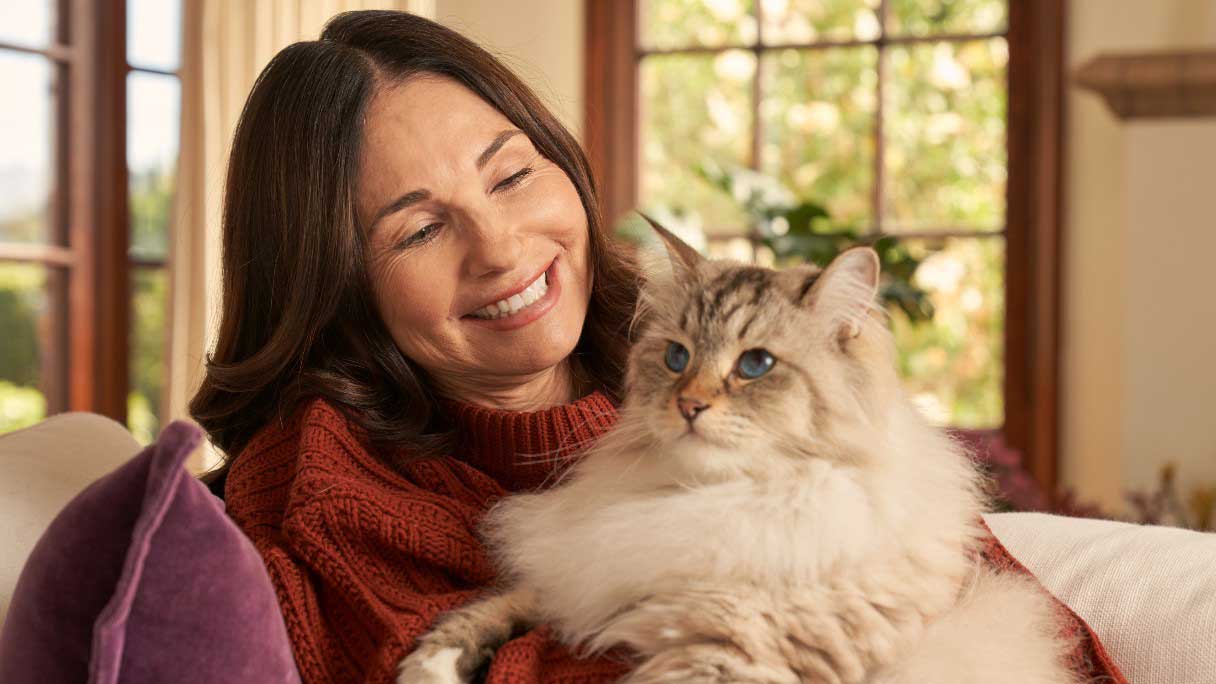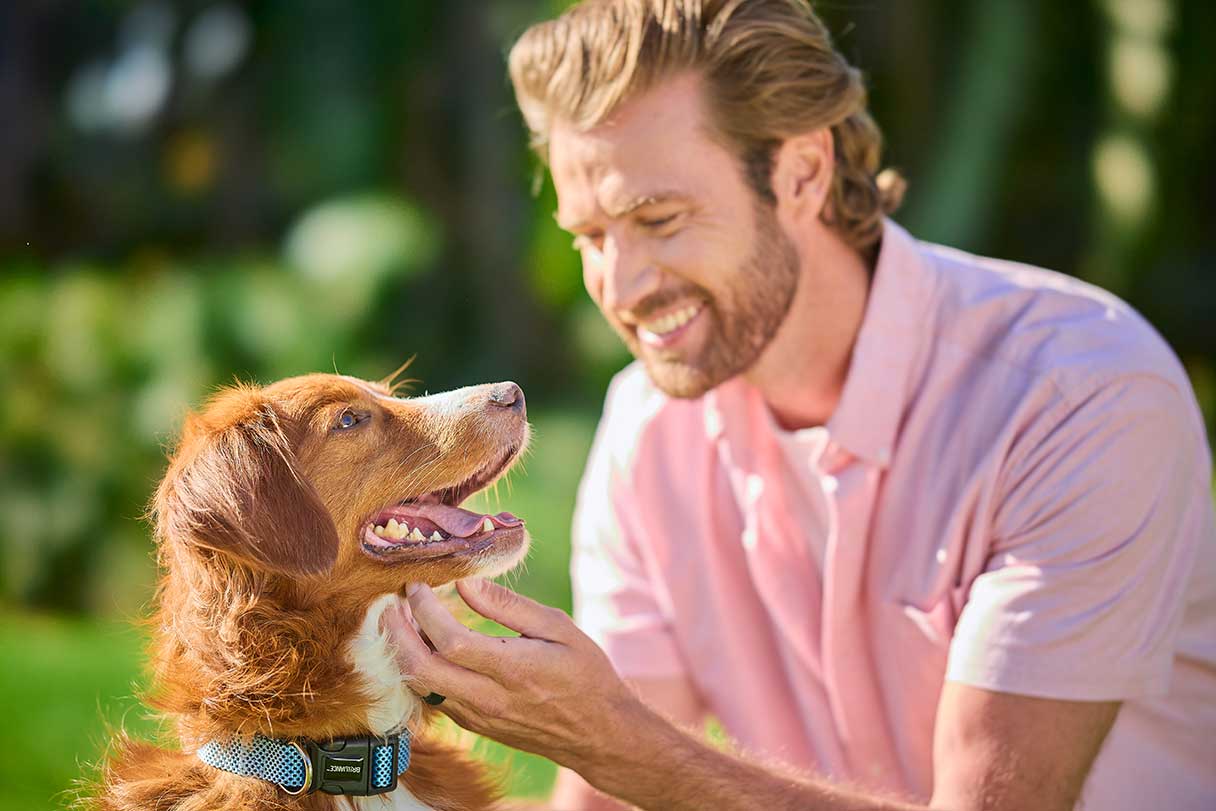If you want a loyal love bug who is also an excellent guard dog and all-around family companion, look no further than the boxer. Large and lean with a squishy baby face, the boxer manages to look rough and tumble as well as sweet and adorable at the same time. All that and smart, too.1
Are you the right person for a boxer? Here’s what you need to know about this breed’s temperament, health and wellness needs and daily care to help you make an informed choice.
About the Boxer
Today’s boxer is a modified descendent of the Bullenbeisser — that’s German for bull biter — a giant hunting dog used in medieval Germany to hunt, catch and hold big game. That dog can trace its roots back to the war dogs of the ancient Assyrian empire.2
In the late 1800s, the German political landscape put an end to big game hunts. During this time, Bullenbeissers were bred with a smaller English mastiff to create the smaller, but still substantial, breed that we know as the boxer, named for their tendency to box with their front paws when fighting or roughhousing.2
Boxers have proven themselves to be capable working dogs over the years, serving as cattle drivers, watchdogs, personal protection dogs, military dogs and Seeing Eye dogs. The American Kennel Club (AKC) registered its first boxer in 1904, and since a surge in popularity in the 1950s, it has remained one of America’s top 10 favorite dog breeds.2
Boxer Appearance
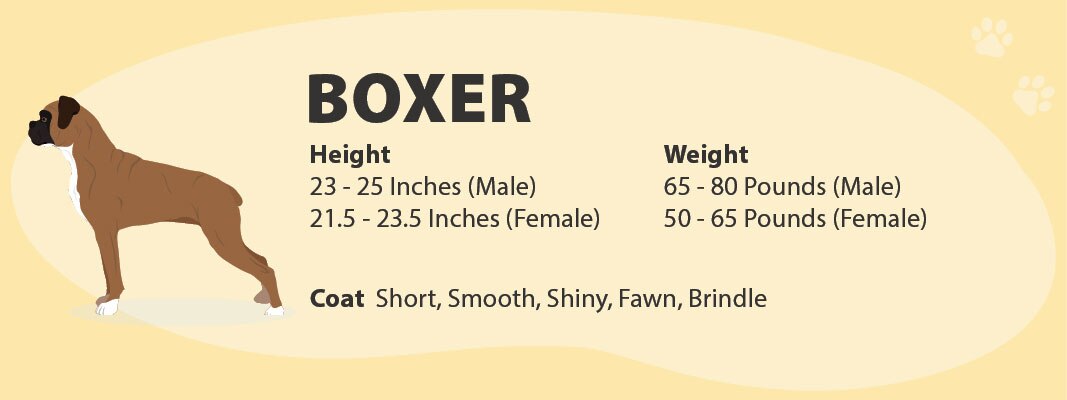
Boxers are large dogs, with males standing 23 to 25 inches at the shoulder and weighing 65 to 80 pounds. Females are slightly smaller, standing 21.5 to 23.5 inches tall and weighing 50 to 65 pounds.2 They’re lean and muscular with a broad, deep chest and a short, straight back with a docked tail.3 It should be noted that the American Veterinary Medical Association discourages tail docking for cosmetic purposes.4
The boxer’s most distinctive feature is its head and face. A rounded skull with erect, alert ears slopes down into a short muzzle that constitutes one-third of the head's length. Large, dark brown eyes look out from beneath brows that furrow when alert. The muzzle ends in a slight underbite and upturned nose, with loose jowls and slight wrinkling on the sides.3
The coat is short and smooth and should shine when healthy. Acceptable colors are fawn and brindle, with fawn varying in shades ranging from light tan to deep mahogany. A boxer may have white markings on the chest, paws or face, along with a black mask around the eyes.3
Boxer Temperament
Boxers are fearless protectors who adore children and are also affectionate and loyal.2 They soak up love and want nothing more than to bask in the presence of their people.1 Despite their protective nature, boxer dogs are generally friendly and accepting of unknown humans, although they will bark to alert you to stranger danger.2 That said, they’re not prone to barking without good reason.1
Boxers can get along well with other dogs, but they generally do best with dogs of the opposite sex.2 Prospective boxer owners with cats or other small pets should be aware that this breed has a high prey drive and needs to be taught the difference between pets and prey.5 Plenty of exposure and socialization while they’re puppies should help.2 This, along with obedience training, can help these energetic and enthusiastic dogs learn self-restraint and good manners.2
Training won’t be difficult with this whip-smart breed, although they can easily bore with too much repetition. Keep boxer training interesting by varying exercises, keeping sessions short and positive and providing plenty of rewards. Overall, boxers are excellent pupils who are capable of learning a wide range of tasks, tricks and canine sports.2
Living With a Boxer
Boxers are great family pets and all-around good dogs, but that doesn’t mean they’re the right breed for everyone. Here’s what you need to know about living with and caring for boxers, including helpful tips for both current and prospective boxer owners.
Who they’re best for
Boxers need a home where they can get lots of love and attention and be treated like part of the family.1 They’re ideally suited for families with children, although they can be a little too exuberant to play with small children without close supervision.2 They can form tight bonds with grown-ups as well and fit well into families of any size.2
Prospective boxer owners should be prepared to spend a good deal of time each day training, exercising and playing with their boxer. They’ll thrive with an active owner who can keep up with their energy and provide plenty of activity and mental stimulation.2
Boxer puppies can learn to get along well with other dogs, cats and household pets when raised with them.5 But if you’re getting an older boxer, it’s probably best if you don’t have any small pets.5 And keep in mind that this breed gets along best with dogs of the opposite sex.2
Living space
A boxer would thrive in a country or farm setting where they can be put to work, but these adaptable dogs can do just as well in a large city apartment as long as they get plenty of walks and playtime each day.2
These aren’t dogs who can be set free to roam off-leash, however, even on large acreage. Their prey drive makes them too much of a flight risk. If you can’t spend sufficient time walking them each day, then an exercise yard with a tall, escape-proof fence is a must.2
Exercise and activity
Boxers need at least two hours of exercise and activity each day.5 This can be split up into multiple walks, backyard play and training sessions.5 A boxer would also make an excellent hiking buddy.
If you’re thinking about getting a boxer and don’t have a fenced yard, you should consider whether you’re willing and able to get out and walk your dog in any kind of weather. A doggie treadmill could suffice to get them through inclement weather.
This breed tends to love and excel at dog sports like obedience, herding and agility, as well as tracking sports.2 Boxer parents who find it a challenge to meet all their activity needs could consider enrolling them in classes that provide an outlet for that boxer energy.
Grooming
The boxer’s coat is extremely low maintenance. It tends to stay clean on its own, so baths are only needed when they get dirty. Otherwise, a weekly once-over with a rubber glove brush to remove stray hair and debris will help keep their coat in pristine shape.2
When brushing boxers, you should also inspect the skin folds around their face to remove debris that could cause irritation, and be sure to dry these areas well when bathing them or after a swim.5
Your boxer’s nails may stay naturally worn down from all those walks, but if not, they’ll need to be trimmed once a month or so. Because the shape of a boxer’s mouth causes tooth crowding, they will need daily toothbrushing to prevent tartar buildup and keep their teeth and gums healthy between veterinary dental cleanings.2
Boxer Health and Life Expectancy
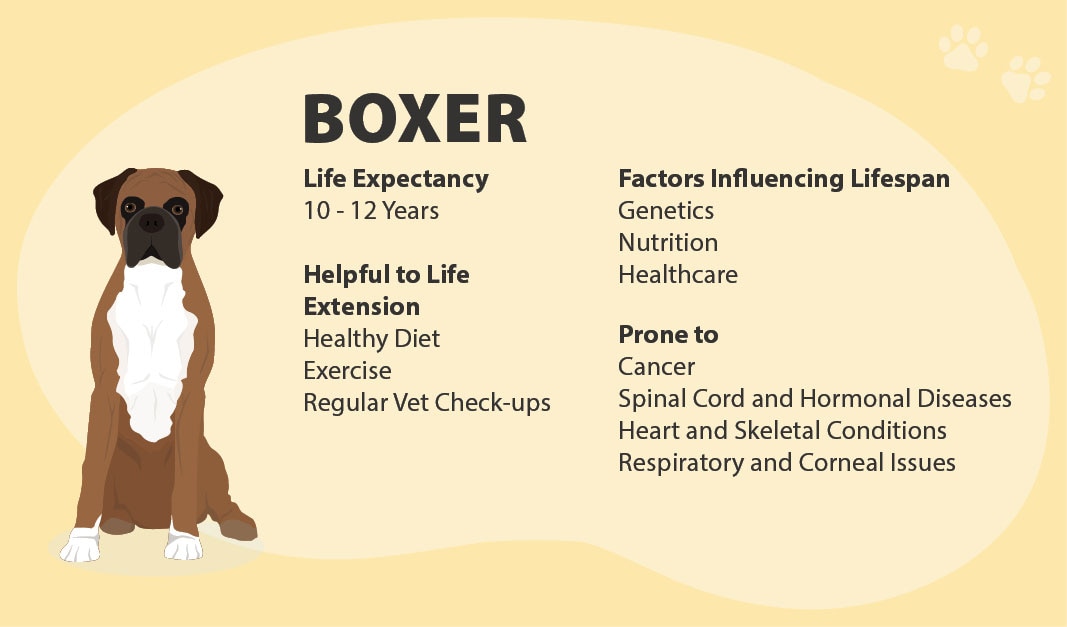
Boxers live 10 to 12 years on average.2 That said, your individual dog’s genetics, nutrition and healthcare are all factors that influence their lifespan. A healthy diet, plenty of exercise and regular veterinary checkups may help your pup live longer.
Boxers typically do well when fed high-quality dog food that’s appropriate for their current life stage.2 Look for food with a nutritional profile that’s been approved by the Association of American Feed Control Officials, and talk to your vet about the best amount to maintain their ideal weight and avoid obesity.2 As a large breed, it’s best to feed your boxer a large-breed dog or puppy formula, which contains nutrients that can support large and rapidly growing bones.6
Responsible boxer breeders conduct genetic testing and health assessments to identify and eliminate hereditary health issues as much as possible Even so, boxers may face some health issues that require veterinary care or ongoing management. Current and prospective boxer parents should be aware of these potential health issues:2
Cardiomyopathy
Boxers have a higher chance of developing certain heart conditions, including cardiomyopathy.5 This involves the heart becoming enlarged due to weakened muscle walls and the inability to pump blood efficiently. This often results in a heart murmur and is the most common reason dogs develop congestive heart failure.7
Aortic stenosis
Another potential heart condition in boxers is aortic stenosis, which involves a narrowing of the aortic valve. This causes the heart to have to work harder to pump blood through the opening. More severe cases can also lead to heart failure and place dogs under threat of sudden death, but mild cases can be managed with medication if they need to be managed at all.8
Degenerative myelopathy
Degenerative myelopathy (DM) is a spinal cord disease similar to ALS, or Lou Gehrig’s disease, in humans. Dogs with DM experience a slow progression of weakness in the hind limbs that eventually leads to paralysis. While there is no effective treatment or cure, physical therapy may help slow down the disease and improve mobility and quality of life.9
Cancer
Boxers are predisposed to certain types of cancer.2 It’s important to keep up with annual health screenings for your boxer and to report any unusual lumps or bumps, as well as unexplained changes in their overall health or behavior, to your vet.10
Hypothyroidism
Low thyroid hormone production causes metabolism to slow down, which can result in various health issues. Signs include lethargy, weight gain and a dull or thinning coat. This disease, while common in boxers, can be managed with thyroid replacement medication.11
Hip and elbow dysplasia
Dysplasia is a condition in which the ball of the joint fits poorly into the socket. With boxers, this can affect both the hips and the elbow joints. It’s a painful condition that, if left untreated, can lead to osteoarthritis. Mild cases can be managed with nutrition and lifestyle adjustments, while more severe cases require surgical treatment.12
Brachycephaly syndrome
Brachycephaly is Greek for short head. While the shape of a boxer’s head and snout is not itself a health condition, it places them at a higher chance of airway obstructions that may cause respiratory issues, excessive snoring, exercise intolerance and heat intolerance, all of which can reduce quality of life. This also places boxers in danger of getting heat stroke. Surgery may be able to remove some obstructions and improve respiration, but you may wish to take extra care to help your boxer stay cool and avoid overexertion.13
Corneal ulcers
Another issue common to brachycephalic dogs is that the shape of the skull causes the eyes to protrude, making them more prone to injury.13 Trauma to the eyes can result in corneal ulcers, which are painful sores on the cornea that can result in blindness.14 Treatment depends on the severity and may involve medication or surgery.14
Buying or Adopting a Boxer
The average price to purchase an AKC-registered boxer puppy from a reputable breeder generally ranges from $1,200 to $3,00015 or more, depending on factors such as location and whether the parents are from championship lines. The cost typically includes early healthcare, vaccinations and genetic testing.15
Boxers and boxer mixes of all ages are often available through pet shelters and boxer rescue organizations. Adoption fees may vary depending on location and the age of the dog, as well as any special needs it may have and veterinary care it received. The cost to adopt a boxer typically ranges from $22516 to $40017 or more, which usually covers the cost of vaccinations, spaying or neutering and other necessary vet care.
You can find a list of reputable boxer rescue organizations across the U.S. on the American Boxer Club’s website.
Frequently Asked Questions About Boxers
Here are some common questions people are asking about boxers.
CareCredit Credit Card Financing for Dogs
The CareCredit credit card provides a convenient way to pay for your dog's vaccinations and other health and wellness expenses, including exams, medications and products at providers in the CareCredit network.* Continue your wellness journey by downloading the CareCredit Mobile App. You can find a provider on the go, manage your CareCredit account and easily access the Well U blog for more great articles, podcasts and videos. Use our Acceptance Locator to find a veterinarian that accepts CareCredit to help keep your pet healthy and happy for a lifetime of love.
In addition to pet care, you can also use your CareCredit credit card for dentistry, cosmetic, vision, hearing, health systems, dermatology, pharmacy purchases, spa treatments and so much more within the CareCredit network. How will you invest in your health and wellness next?
Author Bio
Jean Marie Bauhaus is a freelance writer and novelist who has been writing pet content since 2013. Her work has appeared on Forbes.com, Hill's Pet, Chewy, AKC.org and more.





